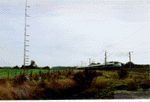|
|
|
TGVweb > Multimedia > TGV Photos > Research |
Serve this page from: California, USA / Pisa, Italy |
 |
The P-01 tilting demonstrator. For more information about this train, see here. Photo by Yann Nottara (ynottara@mail.dotcom.fr) |
|||||||||||||||||||||||||
 |
The P-01 tilting prototype, showing the gap with the power car when the trailers tilt. The prototype's power cars do not tilt. For more information about this train, see here. Photo by Yann Nottara (ynottara@mail.dotcom.fr) |
||||||||||||||||||||||
 |
The laboratory car in trailer R1 of the P-01 tilting prototype. This equipment was used to monitor and analyze the performance of the trainset during several months of testing. Photo by Yann Nottara (ynottara@mail.dotcom.fr) |
|||||||||||||||||||
 |
In the face of fierce competition from Japan, arch-rivals Siemens and GEC-Alsthom cooperated with the Eurotrain joint venture to try to win the new Taiwanese high speed rail system. The unlikely result was this hybrid demonstration train, composed of German ICE2 power units 402 042 and 402 046 and the trailers of French TGV Duplex trainset 224. This May 1998 photo shows one of the German power units, redecorated to match the TGV trailers. The train was tested up to 316 km/h on the German high speed line between Hannover and Göttingen and demonstrated for Taiwanese dignitaries. Modifications for the test included feeding 15kV power through the Duplex roof cable to the leading ICE unit, installing an additional converter in trailer 294224 for compatibility with the ICE's 1000V AC head end power and installing extra data lines between the two ICE units. Electropneumatic braking systems were incompatible, so braking was done pneumatically only. The Eurotrain consortium lost to the Japanese consortium. Photo: Dierk Lawrenz / Eisenbahn-Kurier. Scan: Tobias Urban (tobias.urban@t-online.de) |
||||||||||||||||
A helping hand... 7-year old PSE trainset 12 tows the German ICE-V prototype on the LGV Sud-Est high speed line in 1988. Photo: Yves Broncard. Scan: Yann Nottara (ynottara@mail.dotcom.fr) |
||||||||||||||

|
In 1983/84, the TGV 001 prototype was used once again to help investigate problems with the TGV's secondary suspension and develop the new SR 10 secondary suspension. Note that a PSE trailer is inserted in the TGV 001 trainset! Photo: Yves Broncard. Scan: Yann Nottara (ynottara@mail.dotcom.fr) |
||||||||||

|
A Thalys trainset undergoing acoustic measurements at 330 km/h, in Belgium, during a testing campaign in 1996. See explanation of acoustic testing. Photo courtesy of A.C. Geerlings (geerlings@tpd.tno.nl) |
|||||||

|
Another acoustic test setup, this time with a TGV Atlantique in 1994. See explanation of acoustic testing. Photo courtesy of A.C. Geerlings (geerlings@tpd.tno.nl) |
||||

|
TGV Réseau trainset 534 in acoustic impact testing for the TGV NG program, on line LN3, 17 January 1996. To reduce aerodynamic noise, the bogies and parts of the roof were shrouded, windows were made flush by adding a layer of glazing, and gaps between cars were covered with rubber stretch membranes. CX pantographs were also fitted. Photo: Guy Laforgerie (AFAC). Scan: Yann Nottara (ynottara@mail.dotcom.fr) |
|
|
TGVweb > Multimedia > TGV Photos > Research |